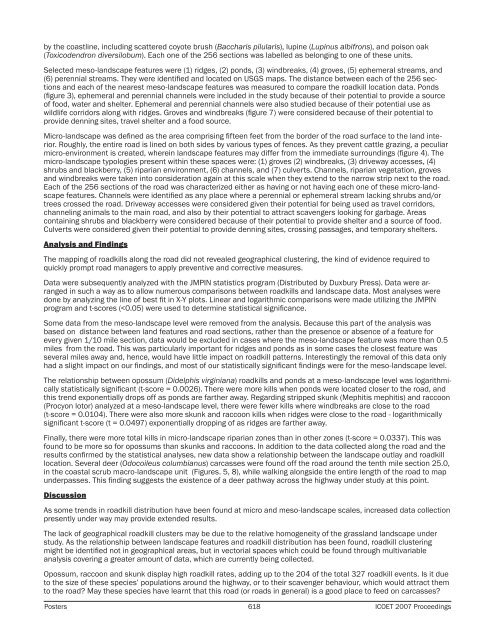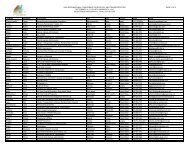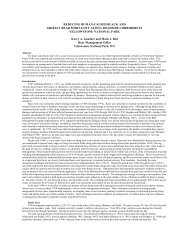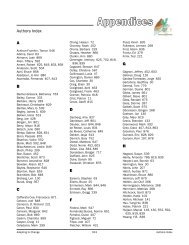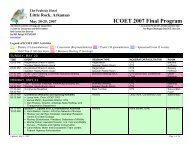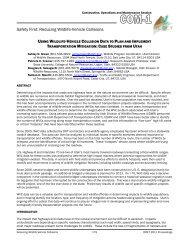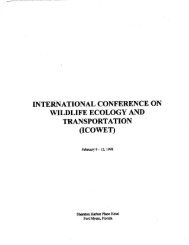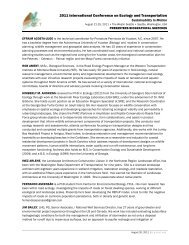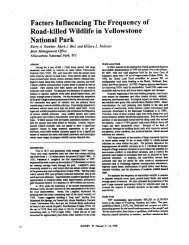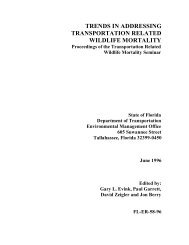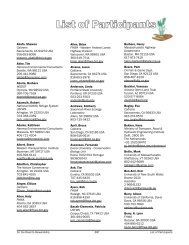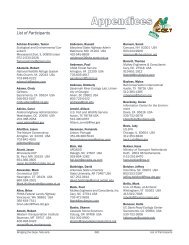Poster Sessions, pages 567-640 - ICOET
Poster Sessions, pages 567-640 - ICOET
Poster Sessions, pages 567-640 - ICOET
Create successful ePaper yourself
Turn your PDF publications into a flip-book with our unique Google optimized e-Paper software.
y the coastline, including scattered coyote brush (Baccharis pilularis), lupine (Lupinus albifrons), and poison oak<br />
(Toxicodendron diversilobum). Each one of the 256 sections was labelled as belonging to one of these units.<br />
Selected meso-landscape features were (1) ridges, (2) ponds, (3) windbreaks, (4) groves, (5) ephemeral streams, and<br />
(6) perennial streams. They were identified and located on USGS maps. The distance between each of the 256 sections<br />
and each of the nearest meso-landscape features was measured to compare the roadkill location data. Ponds<br />
(figure 3), ephemeral and perennial channels were included in the study because of their potential to provide a source<br />
of food, water and shelter. Ephemeral and perennial channels were also studied because of their potential use as<br />
wildlife corridors along with ridges. Groves and windbreaks (figure 7) were considered because of their potential to<br />
provide denning sites, travel shelter and a food source.<br />
Micro-landscape was defined as the area comprising fifteen feet from the border of the road surface to the land interior.<br />
Roughly, the entire road is lined on both sides by various types of fences. As they prevent cattle grazing, a peculiar<br />
micro-environment is created, wherein landscape features may differ from the immediate surroundings (figure 4). The<br />
micro-landscape typologies present within these spaces were: (1) groves (2) windbreaks, (3) driveway accesses, (4)<br />
shrubs and blackberry, (5) riparian environment, (6) channels, and (7) culverts. Channels, riparian vegetation, groves<br />
and windbreaks were taken into consideration again at this scale when they extend to the narrow strip next to the road.<br />
Each of the 256 sections of the road was characterized either as having or not having each one of these micro-landscape<br />
features. Channels were identified as any place where a perennial or ephemeral stream lacking shrubs and/or<br />
trees crossed the road. Driveway accesses were considered given their potential for being used as travel corridors,<br />
channeling animals to the main road, and also by their potential to attract scavengers looking for garbage. Areas<br />
containing shrubs and blackberry were considered because of their potential to provide shelter and a source of food.<br />
Culverts were considered given their potential to provide denning sites, crossing passages, and temporary shelters.<br />
Analysis and Findings<br />
The mapping of roadkills along the road did not revealed geographical clustering, the kind of evidence required to<br />
quickly prompt road managers to apply preventive and corrective measures.<br />
Data were subsequently analyzed with the JMPIN statistics program (Distributed by Duxbury Press). Data were arranged<br />
in such a way as to allow numerous comparisons between roadkills and landscape data. Most analyses were<br />
done by analyzing the line of best fit in X-Y plots. Linear and logarithmic comparisons were made utilizing the JMPIN<br />
program and t-scores (


